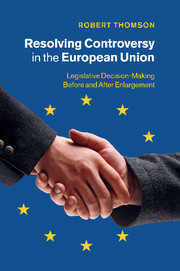 Resolving Controversy in the European Union
Resolving Controversy in the European Union Book contents
- Frontmatter
- Contents
- Figures
- Tables
- Acknowledgements
- 1 Introducing the political system of the European Union
- 2 Research design: measuring controversy spatially
- Part I Inputs
- 3 The European Union’s political space
- 4 The European Commission’s policy positions
- 5 The European Parliament’s policy positions
- 6 Member states’ policy positions
- Part II Processes
- Part III Outputs
- 12 Evaluating and improving the European Union
- Appendix The selection of legislative proposals
- References
- Index
5 - The European Parliament’s policy positions
from Part I - Inputs
Published online by Cambridge University Press: 07 October 2011
- Frontmatter
- Contents
- Figures
- Tables
- Acknowledgements
- 1 Introducing the political system of the European Union
- 2 Research design: measuring controversy spatially
- Part I Inputs
- 3 The European Union’s political space
- 4 The European Commission’s policy positions
- 5 The European Parliament’s policy positions
- 6 Member states’ policy positions
- Part II Processes
- Part III Outputs
- 12 Evaluating and improving the European Union
- Appendix The selection of legislative proposals
- References
- Index
Summary
Policy positions and committee structures in the European Parliament
The fact that the European Parliament (EP) is the only directly elected legislative body in the European Union (EU) gives its policy demands considerable weight in the decision-making process. Under the co-decision procedure, which is now the ordinary procedure, the EP’s formal decision-making power equals that of the Council of Ministers. Even when the consultation procedure applies, the EP appears to influence decision outcomes via the influence it exerts on the Commission (Nugent 2006: 404; Thomson and Hosli 2006b: 414; Kardasheva 2009).
This chapter examines the relevance of two general theories of legislative decision-making to explain variation in the EP’s policy demands. The first theory is the informational theory of legislative committees (e.g., Gilligan and Krehbiel 1989; 1990; Krehbiel 1991). According to this theory, on any given issue the policy position of the chamber as a whole is an unbiased representation of the policy positions of all parliamentarians. The second theory is the distributive theory of legislatures, according to which legislative organization, in particular committee structures and associated procedures, bias the policy positions of legislative bodies (e.g., Ferejohn 1975; Shepsle and Weingast 1987; Weingast and Marshall 1988).
- Type
- Chapter
- Information
- Resolving Controversy in the European UnionLegislative Decision-Making before and after Enlargement, pp. 102 - 131Publisher: Cambridge University PressPrint publication year: 2011


